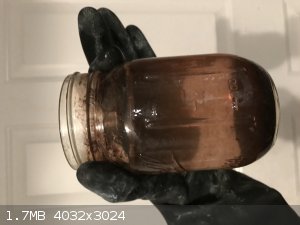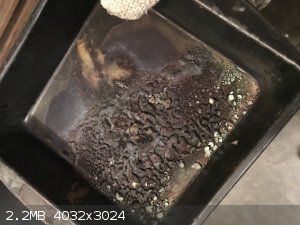| Pages:
1
2 |
teodor
National Hazard
   
Posts: 872
Registered: 28-6-2019
Location: Heerenveen
Member Is Offline
|
|
Today I've made a bit of PbO and PbO2.
1) Pb(NO3)2 + 2HCl = PbCl2 + 2HNO3
PbCl2 is almost insoluble. I think lead acetate could also be used instead of nitrate.
2) PbCl2 + 2KOH + H2O = PbO * nH2O + KCl
After addition of 6M KOH the white lead chloride turns its colour to orange.
3) PbO * nH2O + H2O2 = PbO2 + (n+1) H2O
I just added enough 12% H2O2, the orange lead (II) oxide immediately turned to black-brown lead (IV) oxide. Excess of H2O2 starting to decompose with
evolution of O2 .
No heating was required. To convert all PbCl2 to PbO * nH2O some mixing is required (because the mass becomes dense upon KOH addition).
[Edited on 25-10-2019 by teodor]
|
|
|
fusso
International Hazard
    
Posts: 1922
Registered: 23-6-2017
Location: 4 ∥ universes ahead of you
Member Is Offline
|
|
Why make PbCl2 when ur gonna convert it to the oxide anyways?
|
|
|
Arcaeca
Hazard to Self
 
Posts: 70
Registered: 24-8-2019
Location: Kansas, USA
Member Is Offline
Mood: brøthér, can you spare some B̲̺̹̙̑́̓́ͧ̎ͭ̈́͜L̰̦̼̻͈͖̺͔̇̇̿ͪ̓̃̽ͦŲ̘̲̻͔̀͌͑͑̊͛̑̀͊̕E̐ͮͯ͆̔̾͘͏҉̥̫
|
|
I just filled a mason jar with 1 part lead(II) acetate (concentration unknown, made from lead drywall anchors and unknown quantity of 3% hydrogen
peroxide dumped into some 5% vinegar) and 1 part bleach (5-10% NClO according to the MSDS), and a couple lead anchors and put the mason jar in a
boiling hot water bath until it cooled off. This resulted in a fair amount (by my standards, anyway) of brown precipitate I assume is PbO2.
I could then try to turn this into sodium plumbate with a large excess of NaOH and then combine that with more lead(II) acetate to make the
lead(II,IV) oxide, but frankly it seems easier to make by direct reduction in air at 400 C.
Aaaanyway, since this is the Responsible Practices board, I guess I should ask what to do with the waste products of this reaction. It still smells
faintly of bleach and probably still has at least some lead ions left in solution, but beyond that I have no idea what's in it. I've been collecting
it in a half-gallon mason jar to evenually take to the county hazmat disposal since I don't know what else to do with it.

|
|
|
teodor
National Hazard
   
Posts: 872
Registered: 28-6-2019
Location: Heerenveen
Member Is Offline
|
|
This is a good question. Select any answer you like:
1. To separate lead from other metals which compose the lead alloy which is used in the lead-acid gel battery.
2. To recover nitric acid without distillation, because it is a very good chemical for lead extracting.
3. Because I have no idea how to get PbO from Pb(NO3)2 by water chemistry methods. Pb(NO3)2 + KOH gives a white precipitate (basic nitrate?) which is
just dissolves again in excess of KOH without forming orange PbO.
[Edited on 26-10-2019 by teodor]
|
|
|
teodor
National Hazard
   
Posts: 872
Registered: 28-6-2019
Location: Heerenveen
Member Is Offline
|
|
So, you have a lot to improve.
Quote: Originally posted by Arcaeca  |
Aaaanyway, since this is the Responsible Practices board, I guess I should ask what to do with the waste products of this reaction. It still smells
faintly of bleach and probably still has at least some lead ions left in solution, but beyond that I have no idea what's in it. I've been collecting
it in a half-gallon mason jar to evenually take to the county hazmat disposal since I don't know what else to do with it.
|
First, and it is most important, also not evident from your photo - all your products must be inside some containers (not outside). You should think
literally about every drop when you work with such compounds.
Second, and that is what I do, for products which have basic pH - I collect them in a container with enough Na2CO3 to convert lead salts to insoluble
lead carbonate (for acidic products H2SO4 could be possible better, to avoid gas formation). I put also filter papers and the first portion of water
when I wash glassware into that container also. Generally, you can find information about disposal methods using google search in this forum.
[Edited on 26-10-2019 by teodor]
|
|
|
Arcaeca
Hazard to Self
 
Posts: 70
Registered: 24-8-2019
Location: Kansas, USA
Member Is Offline
Mood: brøthér, can you spare some B̲̺̹̙̑́̓́ͧ̎ͭ̈́͜L̰̦̼̻͈͖̺͔̇̇̿ͪ̓̃̽ͦŲ̘̲̻͔̀͌͑͑̊͛̑̀͊̕E̐ͮͯ͆̔̾͘͏҉̥̫
|
|
So I put all the still wet PbO2 precipitate I had in a metal baking pan and put it over my makeshift kiln as a lid - the thinking being that
allegedly in oxygen PbO2 decomposes to Pb3O4 around 400 C or so, so the hot gases in the kiln could heat the bottom of the pan, which would
transfer the heat to the PbO2 which could be oxygenated from above. This would be easier with better temperature control with a hotplate or furnace
and borosilicate glassware, but as I have none of those, I have to work with what I have.
After the remaining liquid boiled off, I was left with this residue, which certainly doesn't look like Pb3O4, and I'm not really sure what it is. It's
likely the kiln simply didn't get hot enough so the black stuff could be some other lead oxide that PbO2 decomposes to at a lower temperature, or
maybe it's the product of decomposed lead acetate that was unreacted in solution, or some side product with residual NaClO at high temperatures? I
have no idea what this but it's certainly not the reddish-orange I was going for.

|
|
|
S.C. Wack
bibliomaster
    
Posts: 2419
Registered: 7-5-2004
Location: Cornworld, Central USA
Member Is Offline
Mood: Enhanced
|
|
...after treatment with PbO and NaOH...a black char may have something to do with using vinegar, unless the acetate was recrystallized or something
(although nice crystals are possible from vinegar IME).
|
|
|
Arcaeca
Hazard to Self
 
Posts: 70
Registered: 24-8-2019
Location: Kansas, USA
Member Is Offline
Mood: brøthér, can you spare some B̲̺̹̙̑́̓́ͧ̎ͭ̈́͜L̰̦̼̻͈͖̺͔̇̇̿ͪ̓̃̽ͦŲ̘̲̻͔̀͌͑͑̊͛̑̀͊̕E̐ͮͯ͆̔̾͘͏҉̥̫
|
|
Okay, I've never heard of this in any procedure for making Pb3O4. I thought PbO2 could be reduced in air directly to Pb3O4.
So to be clear: once I've made brown PbO2, I know dissolving it in a strongly alkaline solution yields some light-colored slightly yellowish
precipitate, and then I do what to make reddish-orange? Just heat it to 400 C or am I missing something?
|
|
|
S.C. Wack
bibliomaster
    
Posts: 2419
Registered: 7-5-2004
Location: Cornworld, Central USA
Member Is Offline
Mood: Enhanced
|
|
It's #2 from the link on the first page, taken from my scan of Blanchard. No doubt both the oxide and tetroxide can be formed by heating the dioxide,
but there is usually a good reason for processes more than a sentence long.
|
|
|
teodor
National Hazard
   
Posts: 872
Registered: 28-6-2019
Location: Heerenveen
Member Is Offline
|
|
Oh, indeed, I found it, Blanchard N 48/2 . It is much simpler wet method than in Brauer, which depends on Na2[Pb(OH)6] which is rather complex to get.
Thank you for the information.
|
|
|
| Pages:
1
2 |